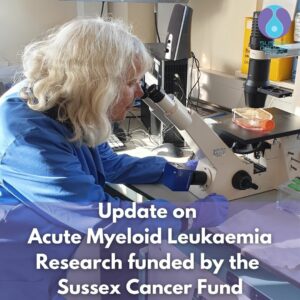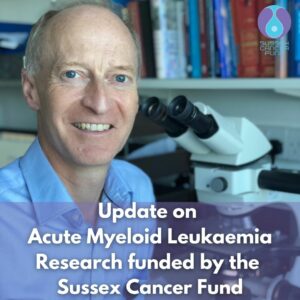
Acute Myeloid Leukaemia Research.
The Sussex Cancer Fund is currently funding an exciting research project at Brighton and Sussex Medical School (BSMS) that is focused on discovering new treatments for a devastating disease called Acute Myeloid Leukaemia. The lead investigator on this project is Dr Tim Chevassut, Consultant Haematologist at the Royal Sussex County Hospital and Reader in Haematology at the University of Sussex, and the research itself is being done by Dr Helen Stewart, Senior Scientist, based at the BSMS Medical Research Building at Falmer. The project has recently lead to a major publication in a prestigious journal, Nature Communications, and we are delighted to be in a position to continue that funding for a further year.
We wanted to share some of the good work of the project with our supporters, so we caught up with Tim and Helen to hear more about the latest progress of this project.
Tim, please can you give us an introduction to yourselves and a summary of the project?

Tim Chevassut, “My pleasure! We are truly delighted to be funded by the Sussex Cancer Fund which is supporting my colleague, Helen, to carry out some very important research into blood cancer. I’m a Clinical Haematologist at the Royal Sussex County Hospital and I run a research laboratory at BSMS where my main focus for the last 10 years has been trying to understand a particular type of leukaemia called Acute Myeloid Leukemia, or AML.
AML is a devastating diagnosis and one which still we don’t have great treatments for, so what we’re trying to do is to understand more about this disease, its biology, and particularly its genetics. More important still, we are striving to understand how we can treat this disease better using new drugs, that can target specific genes and one gene in particular called DNMT3A, which we know is commonly mutated in this particular type of leukaemia.
We are very excited at the moment because some of our work, which we’ve been engaged with for several years now, has just been accepted for publication in a leading journal called Nature Communications. We hope that this work might lead in time to a clinical trial here in Brighton and Sussex. This paper is a collaboration with other researchers in Scotland and America that is based on work done at BSMS and funded by the Sussex Cancer Fund. More importantly, it would not have been possible without the blood and bone marrow samples that have been kindly donated by patients here in Brighton as part of this research.
So that is the work we do and it’s an honour to be funded by the Sussex Cancer Fund and to be working so closely with such wonderful patients that I have had the privilege of looking after and getting to know so well.”
What are your Roles?
Tim Chevassut, “As well as being a haematologist at the Royal Sussex County Hospital, where I work with six consultant colleagues, I am also based at Brighton and Sussex Medical School which part of the Universities of Sussex and Brighton. My job is split between doing research and seeing haematology patients. I see many patients who have different forms of blood cancer such as lymphoma, myeloma and leukaemia, but it is AML that is the main focus of my research.”
Helen Stewart, “I am a postdoctoral scientist with many years of research experience in the UK and abroad but for the past 15 years I have been based at BSMS and for most of that time I have been working closely with Tim as the senior scientist in his lab. We have published numerous papers together on various different types of blood cancer but our main focus over the past 5 years has been AML which remains an incurable disease for most patients unfortunate enough to receive such a diagnosis. Having grown up as a child in Brighton, it is a privilege to be funded by the Sussex Cancer Fund and to find myself working to improve the lives of patients here in Sussex.”
Why is this project so important?
Tim “AML is a disease I’ve encountered numerous times as a doctor and can affect young and old alike. However, if you are over the age of 60, then it’s clear that the prognosis isn’t so good. Most people don’t survive this disease sadly and, for older people, survival is often measured in months which is terribly difficult. For this reason, we really need to understand more about the disease and how we can better treat our patients.
Interestingly, the backbone of AML treatment hasn’t changed much for over 40 years, which is remarkable given the advances that have been made in other areas of medicine, and even though we do more stem cell transplants now, they are only really an option for younger fitter people.
The problem is that while the drugs we use are quite good at getting patients into remission, they are not very good at curing the disease. Typically, the response to treatment is short-lived, making the patient better for a year or two until the disease relapses. At that point, it is very difficult to treat the patient again as the disease becomes resistant to the drugs. This is a common problem in other cancers but it’s particularly a problem in Acute Myeloid Leukemia.
We know more about AML than we do about any other type of cancer because it’s very easy to get hold of the cancer cells from the blood. You can take a blood test and purify the leukaemia cells, analyse them, and see what they look like in terms of their characteristics and more importantly, what the genetic mutations are. It’s one of those genetic mutations which we are particularly interested in and that is a gene called DNMT3A that controls something called DNA methylation which is how cells switch off genes. This mutation is very common in AML which makes it especially important.”
What causes this particular type of Acute Myeloid Leukemia?
“So what do we know about DNMT3A? Well, if you are over the age of 50 or 60, the chance of getting this mutation goes up with each decade of life, and if you look at people who are in their 80s or 90s then quite a large number of people will carry it. What’s interesting about this gene is A) it’s very common and B) it often occurs at the initiation of the process of leukaemia. That’s why we are very interested in understanding the biology of it and how it can be better targeted with drugs, which is what Helen is working on.”
What has your project achieved so far?
“I like to use this analogy. If you imagine a large weed growing upwards then you could chop off different parts of the weed that represent the different mutations, and this is what a lot of drugs do. But it won’t stop the weed growing. Only if you can chop the weed at the root, where our particular mutated gene DNMT3A is found, can you hope to get rid of all the leukaemia cell and prevent the disease coming back.
We have done quite a bit of work on this gene over the years and published a number of papers looking at the mutation and trying to understand how it causes the cell to misbehave by upsetting the DNA machinery? But we don’t yet understand why it causes leukaemia.
Our recent paper in Nature Communications describes a novel treatment for Acute Myeloid Leukaemia based on that work was started here in Brighton and part-funded by the Sussex Cancer Fund some years ago. This was work that Helen did to identify a combination of two drugs that very effectively kills AML cells which we published in 2015. Collaborators of ours from Glasgow and San Diego took the research a stage further and now we have arrived at a point where we are keen to do a clinical trial with this particular combination of drugs. We are currently in negotiations with the drug companies to look at opening a clinical trial.
Our current work has identified a sort of signature in the cells where this gene is not working, which is important because if you can understand what the mutation does to cells then we will understand more about leukaemia. A signature is where you look at all the other genes and see to what degree they are being turned on or off and you see a pattern. The DNMT3A mutation causes a specific pattern in which certain leukaemia genes are being turned on and good genes are being turned off.
Even though we found this signature in cells with DNMT3A, there’s a little bit of a hint that this process is common to other types of AML. So sometimes you focus on one particular type of cancer and then you realise that what you discovered is relevant to other types of cancer, so our discovery may have broader relevance to other types of AML. For this reason, our research might be very important in identifying new therapies for this disease. At the moment, we have three or four candidate drugs that in our experiments seem to effectively kill off cells carrying the DNMT3A mutation, so we are hopeful that new treatments will come from our work.”
So how long will it take to get into clinical trials?
“Because the combination of drugs we have identified in our research are already in clinical use we should be able to move to a clinical trial more quickly than if we were proposing to use a new drug. However, we do have a number of hurdles to overcome yet including persuading the drug company to fund such a study which we hope would be here in Sussex.”
In what other ways is the Sussex Cancer Fund contributing to this research?
“In addition to funding Helen’s work, the Sussex Cancer Fund supports several other research projects happening at BSMS and has also provided funding for specialist equipment. The Sussex Cancer Fund was instrumental in helping fund a tissue bank of leukaemia samples that have been donated by patients being treated here in Brighton. Without this tissue bank, much of our research would not have been possible. And without the contribution of the patients and the support of the Sussex Cancer Fund, this research just wouldn’t have happened at all!”
We would like to thank Tim and Helen for their work and also their time in sharing with us some details of their project and also the patients that have contributed samples to the study and of course our supporters that have made funding this project possible.
If you would like to help the Sussex Cancer Fund support projects like this and others looking to understand cancer better and find new and improved treatments you can donate using the button below.
You can read about another Acute Myeloid Leukaemia Research project the Sussex Cancer Fund is supporting.

